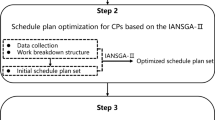Abstract
Even though highway Construction and Maintenance (C/M) projects aim to improve transportation infrastructure and travel services, these highway C/M projects become one of the main reasons for causing traffic congestion on existing road transportation systems as well as traffic accidents in work zone areas. The number of work zones is increasing due to the aging infrastructure, which demands spatial and temporal coordination of these work zones for efficient use of the existing transportation network. Unlike other studies focused on the single C/M project level, this study deals with network-wide impacts of multiple C/M projects. This problem is formulated as a bi-objective multi-period transportation network optimization problem to seek an optimal schedule that coordinates multiple C/M projects. The objectives are to minimize the total system cost and to maintain minimum travel services between origins and destinations. A bi-objective genetic algorithm is employed to solve the multi-period network optimization problem. A numerical example shows that the optimal coordination saves more than 50% of waste in system costs, compared to the worst case scenario.
Similar content being viewed by others
References
Chen, A., Subprasom, K., and Ji, Z. (2006). “A simulation-based multiobjective genetic algorithm (SMOGA) for build-operate-transfer network design problem.” Optimization and Engineering Journal, Vol. 7, No. 3, pp. 225–247.
Chen, A., Kim, J., Lee, S., and Kim, Y. (2010). “Stochastic multi-objective models for network design problem under demand uncertainty.” Expert Systems with Applications, Vol. 37, No. 2, pp. 1608–1619.
Curtis, D. (2001) QuickZone, Public Roads, July/August 2001, FHWA.
Federal Highway Administration (1998). Meeting the customer’s needs for mobility and safety during construction and maintenance operations, Office of Program Quality Coordination, HPQ-98-1, September 1998.
Federal Highway Administration (1998). Life-Cycle cost analysis in pavement design, FHWA-SA-98-079.
Federal Highway Administration (2002). Life-Cycle cost analysis primer, office of asset management, FHWA-IF-02-047, August 2002.
Fwa, T. F., Chan, W. T., and Hoque, K. Z. (2000). “Multiobjective optimization for pavement maintenance programming.” Journal of Transportation Engineering, Vol. 126, No. 5, pp. 367–374.
Gen, M. and Lin, L. (2004). “Multiobjective hybrid genetic algorithm for bicriteria network design problem.” The 8 th Asia Pacific Symposium on Intelligent and Evolutionary Systems, pp. 73–82.
Holland, J. H. (1975). Adaptation in natural and artificial systems, The University of Michigan Press, Ann Arbor, Michigan.
Knowles, J. and Corne, D. (2000). “Approximating the nondominated front using the pareto archived evolution strategy.” Evolutionary Computation, Vol. 8, No. 2, pp. 149–172.
Lee, E. B., Ibbs, C. W., and Thomas, D. (2004). Minimizing total cost for urban freeway reconstruction with integrated construction/traffic analysis, Technical Memorandum TM-UCB-PRC-2004-2.
National Academy of Engineering (2008). Grand challenges for engineering. Washington, DC.
Oak Ridge National Laboratory (2002). Temporary losses of highway capacity and impacts on performance, ORNL/TN-2002/3, May 2002.
Pilson, C., Hudson, R. W., and Anderson, V. (1999). “Multi-objective optimization in pavement management using genetic algorithms and efficient surfaces.” Transportation Research Record 1655, TRB, pp. 42–48.
Sarker, R. and Abbass, H. (2004). “Differential evolution for solving multi-objective optimization problems.” Asia-Pacific Journal of Operations Research, Vol. 21, No. 2, World Scientific, pp. 225–240.
Sarker, R., Liang, K., and Newton, C. (2002). “New evolutionary algorithm for multiobjective optimization.” European Journal of Operational Research, Elsevier Science, Vol. 140, No. 1, pp. 12–23.
Author information
Authors and Affiliations
Corresponding author
Rights and permissions
About this article
Cite this article
Oh, JS., Kim, H. & Park, D. Bi-objective network optimization for spatial and temporal coordination of multiple highway construction projects. KSCE J Civ Eng 15, 1449–1455 (2011). https://doi.org/10.1007/s12205-011-1428-x
Received:
Accepted:
Published:
Issue Date:
DOI: https://doi.org/10.1007/s12205-011-1428-x




